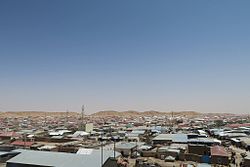Lasanod
|
Las Anod Laascaanood لاس عانود |
|
|---|---|
| Capital of Sool | |
 |
|
| Nickname(s): Laaska, L.A. | |
| Location in Somaliland | |
| Coordinates: 8°28′29″N 47°21′22″E / 8.4746°N 47.3560°E | |
| State |
|
| Region | Sool |
| District | Las Anod |
| Government | |
| • Type | District Council |
| • Mayor | Abdiaziz Hussain Taarwale |
| Elevation | 691 m (2,267 ft) |
| Population (2005) | |
| • Capital of Sool | 75,436 |
| • Urban | 24,830 |
| Time zone | EAT (UTC+3) |
Las Anod (Somali: Laascaanood; Arabic: لاس عانود) is the administrative capital of the northern Sool region of Somaliland. The city was part of the Dervish State until 1921, when it was incorporated into the former British Somalia protectorate.
During the pre-independence period, Las Anod served as an early center for Mohammed Abdullah Hassan's Dervish resistance.
On October 15, 1969, while paying a visit to the city, Somalia's then President Abdirashid Ali Shermarke was shot dead by one of his own bodyguards. His assassination was quickly followed by a military coup d'état on October 21, 1969 (the day after his funeral), in which the Somali Army seized power without encountering armed opposition — essentially a bloodless takeover. The putsch was spearheaded by Major General Mohamed Siad Barre, who at the time commanded the army. Large protests have also been staged in the city against visiting delegations from Somaliland. Additionally, the khaatumo authorities have condemned the occupation and demanded that Somaliland withdraw its troops.
Las Anod is strategically positioned along trade routes in northwestern Somalia. The city is almost surrounded by hills and has considerable water resources, the latter of which makes it a prime destination for peoples from other parts of generally arid Somalia as well as from neighboring countries such as Djibouti and Ethiopia.
According to the UNDP Las Anod has a population of around 75,436 inhabitants. The city is primarily inhabited by people from the Somali ethnic group, with the Dhulbahante sub-clan of the Darod well-represented.
...
Wikipedia

